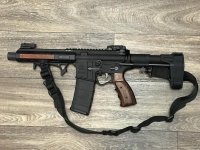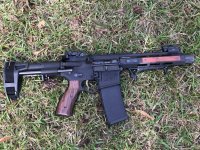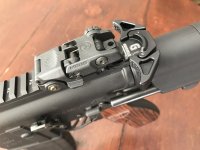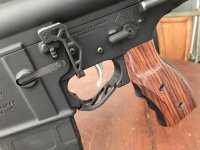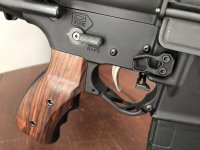I bought one of these in part because I have an inexpensive to shoot 9mm AR-15 pistol (as well as a couple 9mm AR-15 carbines.
I also bought one because I can, and I'm not sure how much longer that will be the case.
Finally, I bought one because it looks like they finally have all the bugs worked out with their third version.
----
In any event, it's been a few years since I've shot anything with a happy switch and this is about as close as it gets without spending serious five digit money, plus paperwork, a long wait, and tax stamp. My expectations however were low.
I received it on Monday, installed it that afternoon in my AR-9 braced pistol, got busy and didn't get it out to the range until Thursday afternoon.

I had low expectations and anticipated problems with functioning, hammer follow, etc, especially installing it on a 9mm AR. Many reviewers have also reported a learning curve before shooters get good results, due to trying to use too short a trigger reset, etc.
I was however pleasantly surprised. I started off with a few single shots, then switched to binary more for a half dozen or so slow single shots on the pull and the release. Then I did a couple rapid pairs before doubling up on the pairs for four round "bursts".
The effect was very much like the good old days doing short bursts with an M16A1, just with two trigger movements rather than one. Then of course I had to try some longer bursts, just because, and the rate of fire was not far behind full auto in an M16A1.

I think prior experience decisively getting on and then off the trigger with the M16A1 and the M60 translated quite well to the binary trigger, ensuring a full release proper reset. Throw in the timing and repetition from double tapping semi-auto pistols, and it was not hard at all to produce a very high and even rate of fire - on the order of 600 rounds per minute, about 3/4ths the rate of an M16A1. But it really shines with short bursts of 2-4 rounds.
It's just as impractical as full auto in an M16 or M4 in most circumstances, but it also makes you smile.
I didn't have any issues with hammer follow (which would have required cycling the charging handle to re-cock the hammer) and only a single instance of coming up short on the reset (which just requires releasing and pulling the trigger again).
I like it enough that I'm now considering getting another one to install in a .223 lower for use with .22 LR.

Oddly enough the biggest challenge was getting accurate shots on the release. It took me awhile to be able to hit an 8" plate with both the pull and release, even when going slow.
I also bought one because I can, and I'm not sure how much longer that will be the case.
Finally, I bought one because it looks like they finally have all the bugs worked out with their third version.
----
In any event, it's been a few years since I've shot anything with a happy switch and this is about as close as it gets without spending serious five digit money, plus paperwork, a long wait, and tax stamp. My expectations however were low.
I received it on Monday, installed it that afternoon in my AR-9 braced pistol, got busy and didn't get it out to the range until Thursday afternoon.

I had low expectations and anticipated problems with functioning, hammer follow, etc, especially installing it on a 9mm AR. Many reviewers have also reported a learning curve before shooters get good results, due to trying to use too short a trigger reset, etc.
I was however pleasantly surprised. I started off with a few single shots, then switched to binary more for a half dozen or so slow single shots on the pull and the release. Then I did a couple rapid pairs before doubling up on the pairs for four round "bursts".
The effect was very much like the good old days doing short bursts with an M16A1, just with two trigger movements rather than one. Then of course I had to try some longer bursts, just because, and the rate of fire was not far behind full auto in an M16A1.

I think prior experience decisively getting on and then off the trigger with the M16A1 and the M60 translated quite well to the binary trigger, ensuring a full release proper reset. Throw in the timing and repetition from double tapping semi-auto pistols, and it was not hard at all to produce a very high and even rate of fire - on the order of 600 rounds per minute, about 3/4ths the rate of an M16A1. But it really shines with short bursts of 2-4 rounds.
It's just as impractical as full auto in an M16 or M4 in most circumstances, but it also makes you smile.
I didn't have any issues with hammer follow (which would have required cycling the charging handle to re-cock the hammer) and only a single instance of coming up short on the reset (which just requires releasing and pulling the trigger again).
I like it enough that I'm now considering getting another one to install in a .223 lower for use with .22 LR.

Oddly enough the biggest challenge was getting accurate shots on the release. It took me awhile to be able to hit an 8" plate with both the pull and release, even when going slow.

